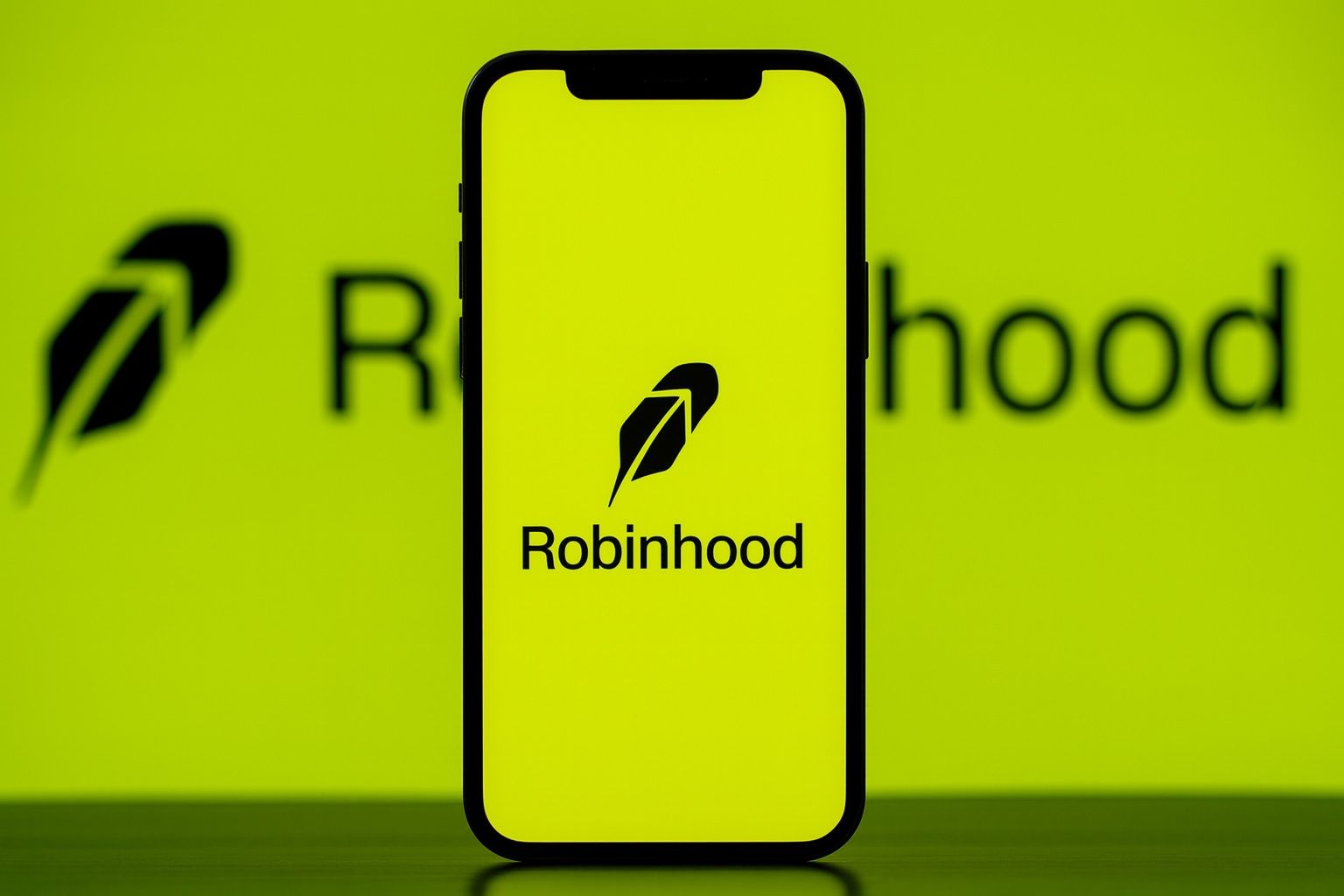- Massive 2025 Surge: Robinhood Markets (NASDAQ: HOOD) shares have surged over 200% year-to-date, recently hitting an all-time high around $153 in early October [1]. Even after a pullback to the mid-$130s, the stock is still up roughly 250% for the year [2].
- S&P 500 Inclusion: In late September, Robinhood was added to the S&P 500 index, a milestone that boosted its market capitalization above $100 billion [3] and raised the trading app’s profile on Wall Street [4].
- Recent Volatility: The stock’s rapid rise has come with big swings. Broader market turmoil (e.g. new tariff threats) triggered a nearly 9% single-day drop on October 10 [5]. This week, shares traded around $132 after a 2.9% dip on Tuesday amid some profit-taking [6], though volumes remain high as investors actively trade the momentum.
- New Partnerships & Outages: Robinhood teamed up with Stanford University Athletics (Oct. 20) in a multi-year partnership to provide financial education for student-athletes [7] [8]. Around the same time, a major Amazon Web Services cloud outage briefly disrupted Robinhood’s platform (and other apps like Coinbase), causing service interruptions on Oct. 20 [9].
- Institutional Backing: Big players are buying in. BlackRock increased its stake in Robinhood by over 40% in Q3, now owning 7.2% of the company (55.8 million shares as of Sept 30, up from 5.2% in June) [10] [11]. Vanguard holds an even larger 12% stake. Hedge funds are circling too – one fund disclosed a new position of ~241,000 shares in October, reflecting confidence in Robinhood’s trajectory.
- Product Innovations: Robinhood is evolving beyond stock trading. It launched advanced features like short-selling and a social trading feed at its 2025 investor summit, closing long-standing feature gaps with traditional brokers [12] [13]. The company also rolled out “Robinhood Banking” for premium users with 4% APY cash accounts and other perks [14], introduced a Robinhood credit card, and listed new assets (from MicroStrategy’s preferred stock to tokenized equities for European customers) [15].
- Crypto Expansion: Crypto remains central. Robinhood completed a $200 million acquisition of Bitstamp, a major crypto exchange, in mid-2025, instantly gaining a foothold in Europe and 50+ global crypto licenses [16]. The platform has added more cryptocurrencies and even piloted 24/7 trading for some assets. In fact, crypto trading on Robinhood jumped 36% in one month (May 2025) even as volumes at rival Coinbase dipped [17] [18]. Robinhood’s CEO Vlad Tenev is openly bullish, famously saying “Tokenization is going to eat the whole global financial system,” underscoring the firm’s long-term crypto ambitions.
- Regulatory Turns: After years of scrutiny, regulators have eased up recently. In February, the U.S. SEC closed its investigation into Robinhood’s crypto business with no enforcement action, a relief following a 2024 warning notice [19]. “The recent closure of investigations into Robinhood and Coinbase by the SEC is a promising development… likely to boost investor confidence,” said one market expert, noting a shift toward clearer crypto guidelines [20]. Earlier in 2025, Robinhood paid a $45 million fine to settle various compliance charges (short-selling rules, recordkeeping, cybersecurity) [21] – showing it’s addressing past issues. Payment-for-order-flow, the controversial practice underpinning its commission-free trades, remains on regulators’ radar, but no bans have materialized.
- Earnings Momentum: Robinhood turned solidly profitable. In Q2 2025, revenue jumped 45% year-on-year to $989 million, while net income doubled to $386 million (EPS $0.42) – a hefty ~50% profit margin [22]. These results crushed analyst expectations [23] and came as user growth accelerated. Funded accounts hit 26.5 million (up 10% YoY) and paid Robinhood Gold subscriptions surged 76% to 3.5 million [24], lifting average revenue per user. The company has guided for continued growth, with Q3 earnings due in early November eagerly anticipated as the next catalyst [25].
HOOD Stock’s 2025 Surge and Recent Pullback
Robinhood’s stock has been on a tear in 2025, vastly outperforming the broader market [26]. After starting the year in the low $30s, HOOD rocketed past $100 over the summer and kept climbing. The rally hit a peak in early October when shares reached about $153, marking a record high for the company [27]. This climb coincided with a major milestone: Robinhood’s inclusion in the S&P 500 index at the end of September, which was hailed as a “watershed moment” for fintech’s legitimacy [28]. Joining the benchmark index not only validated Robinhood as a big-league player, but also forced index funds to buy the stock, fueling additional demand. Robinhood’s market capitalization swelled above $100 billion on the news [29].
However, the ascent hasn’t been without turbulence. In recent weeks the stock has seen higher volatility. For example, on October 10, jittery markets (sparked by new U.S.–China tariff headlines) sent tech shares sliding; Robinhood fell about 8.9% in a single day [30], reminding investors that this high-flyer can drop as quickly as it rises. After notching its highs, HOOD stock has pulled back to the mid-$130s. On Tuesday (Oct. 21), shares closed around $131.84, down roughly 2.9% for the day amid some profit-taking [31]. Despite the dip, Robinhood still boasts a staggering +253% gain in 2025 to date [32].
Market analysts note that such a parabolic run-up may be due for a breather. The stock’s valuation has become rich – trading around 60–70 times earnings, more than double the market average [33]. Technical indicators also flashed that Robinhood was “overbought” in early October (its 14-day RSI momentum indicator topped 70) before the recent cooldown [34]. “The shares had run well ahead of their moving averages, so a short-term correction isn’t surprising,” one strategist noted, pointing out that even after pulling back, HOOD still trades far above its 50-day (~$110) and 200-day (~$79) averages [35]. Many traders are watching to see if the stock can find support around the mid-$130s – roughly the level of recent lows – or if further consolidation is in store [36].
Overall, market reaction to Robinhood’s wild ride has been mixed. Long-term bulls are thrilled with the performance and the company’s fundamental strides (discussed below), while some short-term traders are locking in gains. The stock’s high beta (~2.4) means it tends to swing about twice as sharply as the S&P 500 [37], so outsized moves may continue. Catalysts on the horizon include the upcoming earnings report in early November – any big surprise (good or bad) could quickly reignite the rally or deepen the pullback [38]. For now, HOOD’s 2025 story has been one of remarkable growth tempered by reminders of volatility.
Recent News: Partnerships, Outages, and Analyst Upgrades
Even as the stock charts grabbed headlines, Robinhood made news on several fronts in recent days. Here are some of the latest developments through October 22, 2025:
- College Partnership: This week, Robinhood announced a high-profile tie-up with Stanford Athletics. The multi-year partnership will bring Robinhood’s “Money Drills” financial education program to Stanford University’s student-athletes [39] [40]. As the alma mater of Robinhood’s co-founders, Stanford has a special place in the company’s history. “It’s a special place where industry-disrupting ideas can become reality,” said Chloe Barz, a Robinhood executive, noting that bringing financial literacy tools to campus can help students “navigate the success they may find on campus and beyond” [41] [42]. Stanford’s Athletic Department echoed that sentiment: “This collaboration is about investing in our student-athletes’ futures… [to] equip our student-athletes with financial tools that will help them thrive long after their time at Stanford,” said Stanford Athletics COO Alden Mitchell [43]. The deal, Robinhood’s first with a collegiate sports program, is aimed at building the brand’s image and educating young investors – a natural extension of its large Gen-Z/Millennial customer base.
- Tech Glitch via AWS: On Monday (Oct. 20), a widespread Amazon Web Services outage caused headaches across the internet – and Robinhood was not spared. Users of the trading app, along with those on Coinbase and other platforms, experienced platform disruptions attributed to the AWS downtime [44]. For a few hours, parts of the web went dark due to this cloud computing failure, knocking out everything from payment apps to airlines. Robinhood and Coinbase both reported service outages or slowdowns during the incident [45]. Amazon said it resolved the issues later that day [46] [47], but not before highlighting how even fintech companies rely on third-party infrastructure. The temporary hiccup in Robinhood’s service was quickly resolved with no lasting damage, though it underscored the importance of tech resilience. (It’s actually the second notable outage this month for Robinhood – back on Oct. 6, Robinhood had a separate platform glitch at market open that left many users unable to trade for a brief period [48]. The company has since been bolstering its systems to handle surging activity.)
- Analyst Boosts & Big Bets: Wall Street is paying close attention to Robinhood’s meteoric rise. In mid-October, JMP Securities analyst Devin Ryan made waves by raising his price target on HOOD by 30% – from $130 to $170 – while reiterating an “Outperform” rating [49] [50]. Ryan highlighted that capital markets and fintech stocks have rebounded strongly (up 30–50% since spring lows) amid robust trading activity and fund flows [51]. While he acknowledged valuations are getting stretched in the sector, he still sees select opportunities like Robinhood as attractive [52]. Other analysts have been upbeat as well: in recent weeks, multiple banks hiked their targets – Barclays to $120, Mizuho to $145, Goldman Sachs to $152, Morgan Stanley to $146, and Bank of America to $157 [53]. This flurry of upgrades came on the back of Robinhood’s strong earnings and momentum. Meanwhile, institutional investors are jumping in. The world’s largest asset manager BlackRock revealed in a late Q3 filing that it boosted its stake in Robinhood to 7.2% of shares [54] [55]. BlackRock’s position, now ~55.8 million shares, is up sharply from a 5.2% stake in June – making BlackRock the second-biggest holder after Vanguard [56]. The news helped send HOOD stock up ~7.7% to $139.85 when it hit the tape [57]. Such moves signal growing institutional confidence in Robinhood’s future. Additionally, at least one hedge fund (TB Alternative Assets) disclosed a new multimillion-dollar stake this month, sparking media discussion on whether now is the time to buy into HOOD’s story. All told, Robinhood’s recent headline streak – from partnerships to analyst praise – has kept the stock squarely in the market’s spotlight.
Crypto & Product Moves Fueling Growth
Robinhood’s evolution from a stock-trading app to a more diversified finance platform has been a key storyline in 2025. Much of the company’s upside surprise this year came from product innovation and crypto expansion – areas where Robinhood has been extremely active:
- Crypto Ambitions: Robinhood has doubled down on cryptocurrency as a growth driver. In mid-2025, the company completed its acquisition of Bitstamp, one of Europe’s longest-running crypto exchanges, for a reported $200 million. This deal (first announced in 2024) instantly gave Robinhood a globally scaled crypto platform with operations across the EU, UK, and beyond [58]. Bitstamp brought with it over 50 active crypto licenses and a base of retail and institutional customers, bolstering Robinhood’s international reach. The goal? To transform Robinhood into a global crypto trading powerhouse that complements its U.S. stock business. Crypto trading on Robinhood has indeed been booming – the platform saw a 36% spike in crypto volume in May 2025 (month-over-month), even as volumes at rival Coinbase dipped in that period [59] [60]. This suggests Robinhood may be luring some crypto traders away from pure exchanges by offering a one-stop shop for stocks and digital assets. The company has also expanded the number of cryptocurrencies available to trade and introduced features like crypto wallets that let users move their coins off-platform. Robinhood’s co-founder and CEO Vlad Tenev is extremely bullish on the long-term future of digital assets and tokenization – recently asserting that tokenization could “eat the whole global financial system” as blockchain technology reshapes finance. That bold vision aligns with Robinhood’s strategy of integrating crypto deeper into its platform.
- New Trading Features: On the traditional finance side, Robinhood rolled out a slew of new features geared toward more sophisticated investors. At its second annual “HOOD Summit” this September, the company unveiled plans to allow short selling of stocks and launched a new social trading feed – two major additions. “In our view, short selling and social trading are likely the most impactful product rollouts… at the Summit,” noted Goldman Sachs analyst James Yaro, praising Robinhood for finally adding capabilities long offered by other brokers [61] [62]. Short selling (betting against stocks) was a glaring gap in Robinhood’s offerings – now being filled with what Yaro calls significant “infrastructure enhancements” to enable it [63] [64]. The new social trading platform, on the other hand, lets users follow top traders and invest based on a community feed, akin to features popular on apps like eToro. “The platform enables tracking traders, while allowing direct trading across multiple asset classes from the social feed,” Yaro explained, predicting it will boost user engagement [65]. Robinhood also introduced better charting and technical analysis tools this year to cater to advanced traders. The message is clear: Robinhood is maturing from a simple trading app into a feature-rich broker, hoping to keep users onboard as their financial needs become more sophisticated [66].
- Beyond Brokerage – Toward a ‘Super App’: Robinhood’s long-term aim is to become a comprehensive financial “super-app.” In 2023 it added retirement accounts, and in 2025 it’s expanding into banking-like services. The company began piloting “Robinhood Banking” features for its Gold subscription members, offering checking-like accounts with a 4.0% APY (far above average bank savings rates) along with perks like phone insurance, tax prep, and even estate planning assistance [67]. A Robinhood credit card was also launched, integrating with the app to provide rewards and cash-back into users’ investment accounts. These moves edge Robinhood closer to territory occupied by fintechs like SoFi – catering to many of its customers’ financial needs under one roof. By extending into cash management, credit, and payments, Robinhood deepens its relationship with users (and taps new revenue streams like interest income). The risk is that it now competes not just with brokerages but also banks and fintech lenders. Still, management believes a more diversified product suite will increase the lifetime value of customers and make Robinhood a central hub for young investors’ money. “Robinhood’s momentum results partly from [its] transition from a retail trading brokerage into a sprawling financial services company,” Dow Jones analysts noted, citing the firm’s growth in crypto trading, credit cards, and banking offerings alongside its core brokerage [68] [69]. In short, Robinhood is no longer just about meme stocks – it’s aiming to handle everything from your crypto wallet to your rainy-day savings, which could pay dividends in user loyalty (if executed well).
Regulatory Relief and Ongoing Risks
Robinhood’s disruptive rise hasn’t always endeared it to regulators, but recently the tides have turned a bit in its favor. After the 2021 GameStop saga (where Robinhood infamously halted trading on certain meme stocks) and various compliance issues, the company spent the last few years under a microscope from agencies like the SEC and FINRA. The result was a series of investigations, fines, and mandated changes – growing pains for the once-“move fast and break things” startup.
In January 2025, Robinhood agreed to pay $45 million in fines to settle several regulatory matters [70]. The SEC had charged Robinhood’s broker-dealer units with missteps ranging from violation of short-selling rules (Reg SHO) to inadequate recordkeeping and cybersecurity lapses [71]. By settling and paying the fine, Robinhood put those legacy issues largely behind it – signaling a commitment to compliance as it matures. The company has poured resources into beefing up its legal, risk, and customer service teams, aiming to prevent the kind of outages and support fiascos that plagued it during past frenzies.
Perhaps more significant was news this February: The SEC closed its investigation into Robinhood’s crypto business with no enforcement action [72]. This inquiry had stemmed from a 2024 “Wells notice” warning that the SEC might pursue action over the crypto tokens Robinhood offers. But in 2025, under a new U.S. administration, regulators have taken a less aggressive stance on crypto rules. The SEC, now focused on clarifying guidelines rather than punitive “regulation-by-enforcement,” essentially gave Robinhood’s crypto arm a green light. “The recent closure of investigations into Robinhood and Coinbase by the SEC is a promising development for the crypto industry,” said Scott Acheychek, COO of REX Trading, adding that it “suggests a shift towards clearer regulatory guidelines… For Robinhood, this is likely to boost investor confidence and support its continued expansion in the crypto market.” [73]. That sentiment was echoed by many in the fintech space – after years of uncertainty, the path forward for offering crypto services in the U.S. is looking less treacherous. Robinhood’s stock reacted positively to the news, as investors viewed the resolution as lifting a cloud that had hung over its lucrative crypto trading segment.
That said, regulatory risk hasn’t disappeared. Payment for Order Flow (PFOF) – the practice by which Robinhood routes customer trades to market makers in exchange for fees – remains controversial. The company derives a significant chunk of revenue from PFOF, essentially monetizing commission-free trades. While U.S. regulators stopped short of banning PFOF in 2022-2023, they have hinted at continued monitoring and possible rule tweaks to ensure customers get a fair deal. Any move to restrict PFOF (or impose exchange-style rules on crypto trading) could impact Robinhood’s bottom line. Additionally, state regulators and the SEC are watchful of gamification in trading apps – Robinhood has toned down some confetti and game-like features in response. Overall, after clearing several regulatory hurdles this year, Robinhood is on much firmer footing with watchdogs, but it will need to stay vigilant and invest in compliance to avoid future run-ins. The company’s rapid innovation (crypto, derivatives, etc.) means it will often be venturing into gray areas where rules are still being written.
Competition: Robinhood vs. Coinbase, Schwab & the Rest
Robinhood pioneered commission-free trading and attracted a new generation of investors – but now it faces intense competition on all sides. Its success forced the entire brokerage industry to adapt, and it continues to shake up the competitive landscape in both stock trading and crypto:
- Traditional Brokers: Robinhood’s rise pushed incumbents like Charles Schwab, Fidelity, E*TRADE, and TD Ameritrade to eliminate their stock trading commissions a few years ago [74]. Those giants still command the bulk of customer assets (often from older, wealthier clients) and offer full-service banking and advisory products that Robinhood doesn’t. However, Robinhood’s user base – now over 26 million strong – and inclusion in the S&P 500 show that it has joined the big leagues [75] [76]. In fact, Schwab and others have acknowledged losing some smaller accounts to Robinhood during the pandemic boom. The incumbents are fighting back by touting superior research, a wider range of products (like mutual funds, IRAs), and more robust customer support. Schwab itself faced challenges in 2023–2024 (integration of TD Ameritrade and interest rate pressures), while Robinhood was leaner and tech-focused. As the industry settles, Robinhood is now competing not just on price (free trades for all) but on features and platform experience. Its move into retirement accounts and advisory tools is directly aimed at narrowing the gap with firms like Schwab. On the flip side, Schwab has launched its own sleek mobile apps and fractional trading to appeal to younger investors. The brokerage wars have essentially shifted from fees to who offers the most compelling all-in-one platform for investors.
- Emerging Fintech Rivals: Robinhood isn’t the only app courting the next generation of investors. Rivals such as Webull, SoFi Invest, Square’s Cash App, and eToro have all grown by offering easy, mobile-first trading experiences. Each has its twist – Webull provides advanced charting and paper trading, SoFi bundles trading with loans and banking, Cash App integrates with payments and Bitcoin buying, and eToro popularized social trading. Robinhood still leads in sheer user numbers, but the fintech arms race means it must keep innovating. For instance, social investing was eToro’s niche – now Robinhood has its own social feed. SoFi offers IPO access; Robinhood tried that too with mixed results. The competitive pressure extends to keeping trading costs ultra low (most rivals also charge zero commissions now). With all these apps vying for attention, customer acquisition costs have risen, and brand differentiation is key. Robinhood’s brand got a boost from its meme-stock era fame (sometimes infamy), but it’s working to be seen as a trusted, full-service platform as well. The Stanford partnership and financial literacy campaigns can be viewed partly as efforts to polish its image and build community loyalty in the face of many alternatives.
- Crypto Exchanges: On the cryptocurrency front, Robinhood straddles the line between brokerage and exchange. It offers popular coins and a simple interface, attracting users who like trading crypto alongside stocks in one app. Its biggest pure-play rival is Coinbase, the leading U.S. crypto exchange. For hardcore crypto enthusiasts, Coinbase (and others like Kraken or Binance.US) offer a larger selection of tokens and features like staking, but they charge trading fees. Robinhood’s edge is zero-commission crypto trades and an increasingly robust crypto platform – especially after acquiring Bitstamp. There are signs Robinhood has been gaining share: earlier this year, Robinhood’s crypto trading volumes climbed while Coinbase’s fell [77], which Cantor Fitzgerald analysts noted as a shift. Additionally, as crypto markets rebounded in 2025 (Bitcoin is up ~18% this year [78]), Robinhood’s stock has tended to trade in concert with Bitcoin prices [79] [80]. This suggests that to some extent, investors see HOOD as a proxy for retail crypto enthusiasm. Coinbase, which went public in 2021, has also seen its stock jump in 2025, but Robinhood’s diversified business (equities, options, cash management, etc.) gave it multiple growth engines beyond just crypto trading. That said, Coinbase remains a formidable competitor with deeper crypto-specific capabilities (like an upcoming derivatives exchange). Both companies are converging – Coinbase adding more stocks via tokenization perhaps, and Robinhood adding more crypto infrastructure – potentially even launching overseas crypto services via Bitstamp.
- New Entrants: A sign that Robinhood has truly arrived is that entirely new competitors are launching to target its user base. Case in point: earlier this month, crypto investment firm Galaxy Digital (led by Mike Novogratz) launched “GalaxyOne,” a new app offering commission-free stock and crypto trading plus high-yield savings – explicitly positioning itself as “a one-stop platform for digital natives” akin to Robinhood [81] [82]. GalaxyOne’s debut on Oct. 6 (ironically the same day Robinhood suffered an outage) showed that others see rich opportunity in the market Robinhood created. While it’s too early to tell if GalaxyOne or similar startups will gain traction, Robinhood will have to stay ahead through continuous improvement. The company’s acquisition of Bitstamp, expansion into Europe and Canada, and moves into banking are all partly defensive – to build moats before rivals can undercut its offerings [83]. “Robinhood isn’t standing still,” one industry observer noted, “the company’s goal is to become a global financial super-app, but it must fend off both fintech upstarts and deep-pocketed incumbents in the process.” [84] Competition in brokerage and crypto trading is as intense as ever, but Robinhood’s leadership believes the expansive growth of retail investing and crypto adoption will leave room for multiple winners. For now, Robinhood is fighting to ensure it remains in the lead pack.
What Experts and Analysts Say – Future Outlook
With Robinhood’s stock quintupling from its 2022 lows and more than doubling this year alone, what’s the road ahead? Most experts agree Robinhood has transformed into a serious player with significant long-term opportunities – but opinions vary on how much of that future is already priced into the stock today.
Analyst Sentiment: Wall Street’s consensus on HOOD is cautiously optimistic. According to MarketBeat, the stock carries a “Moderate Buy” consensus rating, with roughly 12 Buy recommendations versus 7 Holds and 1 Sell [85]. Price targets, however, reflect some valuation concern. The average 12-month target is around $118–$120 per share [86], which is actually below the current trading price (mid-$130s). In fact, after the recent rally, a few analysts explicitly noted that Robinhood might be fairly valued around the mid-$130s [87] – for instance, Citigroup upgraded the stock but suggested that levels above $135 already factor in a lot of good news [88]. “Much of the good news is already priced in,” is a common refrain among analysts who love the company’s growth but not its lofty multiples [89]. On the bullish end, some see more upside: Mizuho’s $145 target and Bank of America’s $157 target signal that if Robinhood continues executing, the stock could climb higher [90]. And of course, there are outliers like JMP’s Devin Ryan, who set a street-high $170 target, arguing the market rebound and Robinhood’s momentum warrant a premium [91] [92]. It’s worth noting that even at $170, Robinhood’s forward P/E would be steep, so any target boost tends to hinge on earnings growth accelerating.
Growth Drivers: Those positive on Robinhood’s future cite several drivers. First, secular trends are in its favor: the rise of retail investing, the growing financial engagement of younger generations, and increasing crypto adoption. Robinhood sits at the intersection of these trends with a brand that resonates with Millennials/Gen Z. Its most recent earnings proved it can monetize that engagement – with record revenue and profits in 2025 [93]. The company is now consistently profitable, something that wasn’t true a couple years ago. Bulls argue Robinhood can grow into its valuation by expanding products and markets: for example, offering more crypto internationally (via Bitstamp), rolling out banking services to all users, or even eventually entering new arenas like mortgages or international stock trading. They also point to Robinhood’s high user engagement – millions of daily users checking the app – which could enable cross-selling of new features. The younger demographic is seen as an asset: “Robinhood’s younger user base and high engagement are valuable, as investing habits shift in the digital era,” one analyst noted [94]. As these customers age and have more income to invest, Robinhood could capture an increasing share of their wallets.
Risks and Unknowns: On the other side, skeptics (or at least the cautious voices) emphasize the execution and external risks. Competition is one – maintaining growth when everybody is gunning for you isn’t easy, and there’s a question of whether Robinhood can keep fees at zero and still significantly expand margins long-term (especially as it ventures into lower-margin businesses like banking). Regulation is another overhang; while 2025 brought relief on the crypto front, no one can predict if a future SEC or Congress might clamp down on aspects of Robinhood’s model (be it PFOF, crypto, or even risk disclosures). Moreover, Robinhood’s fortunes are tied to market activity. A slowdown in trading enthusiasm – say, if the meme-stock or crypto frenzy cools off – could hurt growth. We saw a hint of this in 2022 when markets calmed and Robinhood’s user activity dipped. The stock’s high valuation means it is priced for robust growth. If that growth even slightly disappoints, the stock could see a significant correction as multiples compress. For instance, HOOD currently trades at a PEG ratio (price/earnings-to-growth) above 4 [95], indicating a lot of optimism is baked in. Any hint of user growth stalling or revenue missing forecasts might jolt investors.
What to Watch: In the near term, Q3 earnings (due in early November) will be a crucial check-up. Investors will examine if the trends from Q2 (huge revenue jump, higher user numbers) carried into the fall. Particular focus will be on crypto trading revenue (given the Bitcoin uptick and the AWS outage – albeit brief – in October), user growth (are new accounts still climbing post-meme frenzy?), and Robinhood Gold subscription growth (a key source of recurring income). The company’s guidance or commentary on Q4 will also matter, as it heads into a potentially slower holiday trading season.
Looking further out, Robinhood’s inclusion in the S&P 500 itself could attract more steady institutional ownership and dampen volatility somewhat, as index funds hold it for the long haul [96]. However, the stock will likely continue to trade with high sensitivity to the tech sector and crypto markets. Macroeconomic factors like interest rate changes or recession fears can also influence HOOD, since those affect trading appetite and the value of its cash holdings.
Expert Quotes: Many market watchers still wax optimistic about Robinhood’s trajectory despite acknowledging the risks. “Robinhood has evolved from a disruptive upstart to a profitable fintech leader,” said one analyst, “but at current heights the balance of risk and reward is more finely tuned. Long-term investors may want to accumulate on dips rather than chase the stock at peak levels.” [97] In other words, believe in the company – but be mindful of the stock price. Another industry veteran noted that Robinhood’s S&P 500 debut was “a coming-of-age moment for fintech” and that the company now has to prove it can perform like a blue-chip, quarter after quarter [98]. On Robinhood’s aggressive expansion, a fintech columnist quipped, “They want to be the Amazon of finance for Gen Z. Ambitious, yes – but they’ve surprised us before.” The company’s own leaders remain confident. Co-CEO Vlad Tenev often emphasizes “democratizing finance” as a mission, and with the moves into education (like Stanford’s program) and broader financial services, Robinhood is clearly pushing that mission forward on multiple fronts.
The Forecast: Many analysts see continued growth ahead for Robinhood, albeit at a more measured pace than the explosive 2020–2021 period. Revenue is expected to rise in coming quarters as interest income (from user cash) and new product lines contribute alongside trading fees. If the U.S. economy avoids major shocks, retail participation in markets is likely to remain healthy, benefiting brokers like Robinhood. The stock could have upside if earnings keep beating expectations – some bulls think HOOD will justify a price well above $150 if it delivers another year of 30-40% revenue growth. Conversely, a market downturn or crypto slump could make the stock vulnerable to a big pullback; given the high valuation, HOOD might fall harder than the average stock in a correction (as its beta above 2 suggests [99]).
Bottom Line: Robinhood has had a banner 2025, with a soaring stock and major strides in business expansion. It has attracted endorsements from heavyweight investors (BlackRock’s stake shows traditional finance is taking note) and proven that its zero-commission model can be very profitable at scale. Going forward, the company’s challenge will be maintaining momentum – keeping users active and happy even as competition intensifies, and growing into its now much-larger shoes. For investors, Robinhood presents a compelling growth story at the intersection of tech, finance, and crypto. The consensus is that the story is real – Robinhood is here to stay and shape the industry – but the stock’s journey may not be smooth. As one expert put it: Robinhood’s opportunity is huge, but so are the expectations. After a 250% run in one year, all eyes are on what the company does next to justify the hype. Will 2025’s wild ride continue into 2026? Stay tuned – Robinhood has a way of keeping things interesting.
Sources: Recent company news and filings; Stanford Athletics press release (Oct 20, 2025) [100] [101]; Smartkarma Market Brief (Oct 22, 2025) [102] [103]; Reuters and AP reports [104] [105]; InsiderMonkey/Yahoo Finance (analyst commentary) [106] [107]; ts² TechStock² analysis (Oct 2025) [108] [109] [110]; Barron’s/Dow Jones report (Oct 2025) [111] [112]; Benzinga (Goldman Sachs analyst quote) [113] [114]; and other market data as of Oct. 22, 2025.
References
1. ts2.tech, 2. www.smartkarma.com, 3. ts2.tech, 4. ts2.tech, 5. ts2.tech, 6. www.smartkarma.com, 7. gostanford.com, 8. gostanford.com, 9. www.reuters.com, 10. www.fastbull.com, 11. www.fastbull.com, 12. www.benzinga.com, 13. www.benzinga.com, 14. ts2.tech, 15. ts2.tech, 16. ts2.tech, 17. www.reuters.com, 18. www.reuters.com, 19. ts2.tech, 20. www.reuters.com, 21. ts2.tech, 22. ts2.tech, 23. ts2.tech, 24. ts2.tech, 25. ts2.tech, 26. ts2.tech, 27. ts2.tech, 28. ts2.tech, 29. ts2.tech, 30. ts2.tech, 31. www.smartkarma.com, 32. www.smartkarma.com, 33. ts2.tech, 34. ts2.tech, 35. ts2.tech, 36. ts2.tech, 37. ts2.tech, 38. ts2.tech, 39. gostanford.com, 40. gostanford.com, 41. gostanford.com, 42. gostanford.com, 43. gostanford.com, 44. www.reuters.com, 45. www.reuters.com, 46. www.reuters.com, 47. www.reuters.com, 48. ts2.tech, 49. www.insidermonkey.com, 50. www.insidermonkey.com, 51. www.insidermonkey.com, 52. www.insidermonkey.com, 53. ts2.tech, 54. www.fastbull.com, 55. www.fastbull.com, 56. www.fastbull.com, 57. www.fastbull.com, 58. ts2.tech, 59. www.reuters.com, 60. www.reuters.com, 61. www.benzinga.com, 62. www.benzinga.com, 63. www.benzinga.com, 64. www.benzinga.com, 65. www.benzinga.com, 66. www.benzinga.com, 67. ts2.tech, 68. www.fastbull.com, 69. www.fastbull.com, 70. ts2.tech, 71. ts2.tech, 72. ts2.tech, 73. www.reuters.com, 74. ts2.tech, 75. ts2.tech, 76. ts2.tech, 77. www.reuters.com, 78. www.fastbull.com, 79. www.fastbull.com, 80. www.fastbull.com, 81. ts2.tech, 82. ts2.tech, 83. ts2.tech, 84. ts2.tech, 85. ts2.tech, 86. ts2.tech, 87. ts2.tech, 88. ts2.tech, 89. ts2.tech, 90. ts2.tech, 91. www.insidermonkey.com, 92. www.insidermonkey.com, 93. ts2.tech, 94. ts2.tech, 95. ts2.tech, 96. ts2.tech, 97. ts2.tech, 98. ts2.tech, 99. ts2.tech, 100. gostanford.com, 101. gostanford.com, 102. www.smartkarma.com, 103. www.smartkarma.com, 104. www.reuters.com, 105. www.reuters.com, 106. www.insidermonkey.com, 107. www.insidermonkey.com, 108. ts2.tech, 109. ts2.tech, 110. ts2.tech, 111. www.fastbull.com, 112. www.fastbull.com, 113. www.benzinga.com, 114. www.benzinga.com







